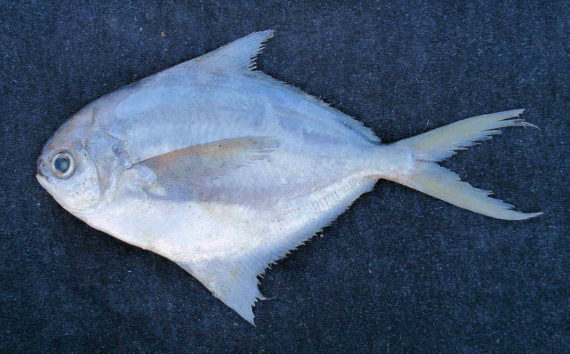Gulf Butterfish, Peprilus burti
 Gulf Butterfish, Peprilus burti. Commercial fish courtesy of the Ranch 99 Market, San Diego, January 2008. Length: 20 cm (7.9 inches).
Gulf Butterfish, Peprilus burti. Commercial fish courtesy of the Ranch 99 Market, San Diego, January 2008. Length: 20 cm (7.9 inches).
The Gulf Butterfish, Peprilus burti, is a member of the Butterfish or Stromateidae Family, and is known in Mexico as palmeta del Golfo. There are seven global members of the genus Peprilus, of which six are found in Mexican waters, two in the Atlantic and four in the Pacific Ocean.
The Gulf Butterfish has a deep oval strongly compressed body that has a depth that is 40% to 48% of standard length. They are pale blue in color and transition to silver ventrally. They are devoid of spots. Their head has a short blunt snout that is smaller than the diameter of the eyes and a small oblique mouth, with a projecting lower jaw equipped with very small teeth, that ends before the eyes; their eyes have a fatty ring around them. Their anal and dorsal fins have very long bases of equal length; both are preceded by 2 to 4 short weak spines and have elevated front lobes that are short and triangular; their caudal fin is deeply forked; their pectoral fins are pointed and longer than the head; and, they do not have pelvic fins. Their lateral line is high on the body and they are covered with small smooth scales.
The Gulf Butterfish is a pelagic species found in large schools over sandy and muddy bottoms at depths up to 245 m (800 feet). They are vertical migrators that spend the majority of their time in very deep water during the day and migrate toward the surface at night. Juveniles are often found under floating weeds and with jellyfish. They reach a maximum length of 25.0 cm (9.8 inches). Adults feed on jellyfish, small fish, crustaceans, and worms; juveniles on plankton and jellyfish. Spawning occurs slightly offshore twice a year at discrete intervals. They mature within one year and rarely live longer than two years. The Gulf Butterfish is poorly studied with very limited information available about their lifestyle and behavioral patterns including specific details on age, growth, longevity, movement patterns, diet, habitat use, and reproduction.
The Gulf Butterfish is a resident of all waters of the the Atlantic Ocean including the Gulf of Mexico and the Caribbean.
The Gulf Butterfish cannot be confused with any other species from the Atlantic due to its body shape and anal and dorsal fins. It is very similar, however, to the Pacific Pompano, Peprilus simillimus (snout longer than eye width) found in the Pacific Ocean.
From a conservation perspective the Gulf Butterfish is currently considered to be of Least Concern with stable widely distributed populations. They are fished commercially and caught primarily with large otter trawl nets. They are sold whole, fresh or frozen, and can be found in great abundance in California ethnic fish markets.